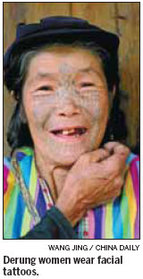Marks of ethnic identity that are more than skin deep
Updated: 2013-12-01 06:48
By Deng Zhangyu(China Daily)
|
|||||||
While modern Chinese increasingly deem tattoos as expressions of individuality, some have since ancient times revered them as identifiers of ethnic belonging.
Records from China's second dynasty, the Shang (c.16th century-11th century BC), and immediately subsequent Western and Eastern Zhou dynasties (c.11th century-256 BC), show some ethnic groups tattooed dragons - still considered river deities by most Chinese - on their bodies. They were etched on flesh to scare off the real dragons as they swam and fished in the rivers.

Tattoos determine who can marry - and who can wed whom - in Hainan province's ethnic Li areas. Many Li people get frog tattoos, as the ethnicity worships the amphibians. Different Li branches are identified by different tattoos - which, in turn, determine who can marry whom.
The Derung have a different tradition in which females were historically protected from intertribal trafficking by their facial tattoos, which made them ugly in many marauders' eyes.
But tradition holds their ancestors won't recognize them in the afterlife without facial ink.
The tattoos not only make Derung women sexually objectionable to other tribes but also strike fear into their hearts, China Association of Tattoo Artists chairman Wang Qingyuan says.
He visited the ethnic group several years ago to understand their traditions.
The Derung are the only ethnic group who still has women with facial tattoos.
"Technology and modernization are replacing ethnic tattoo's functions," Wang says.
(China Daily 12/01/2013 page3)